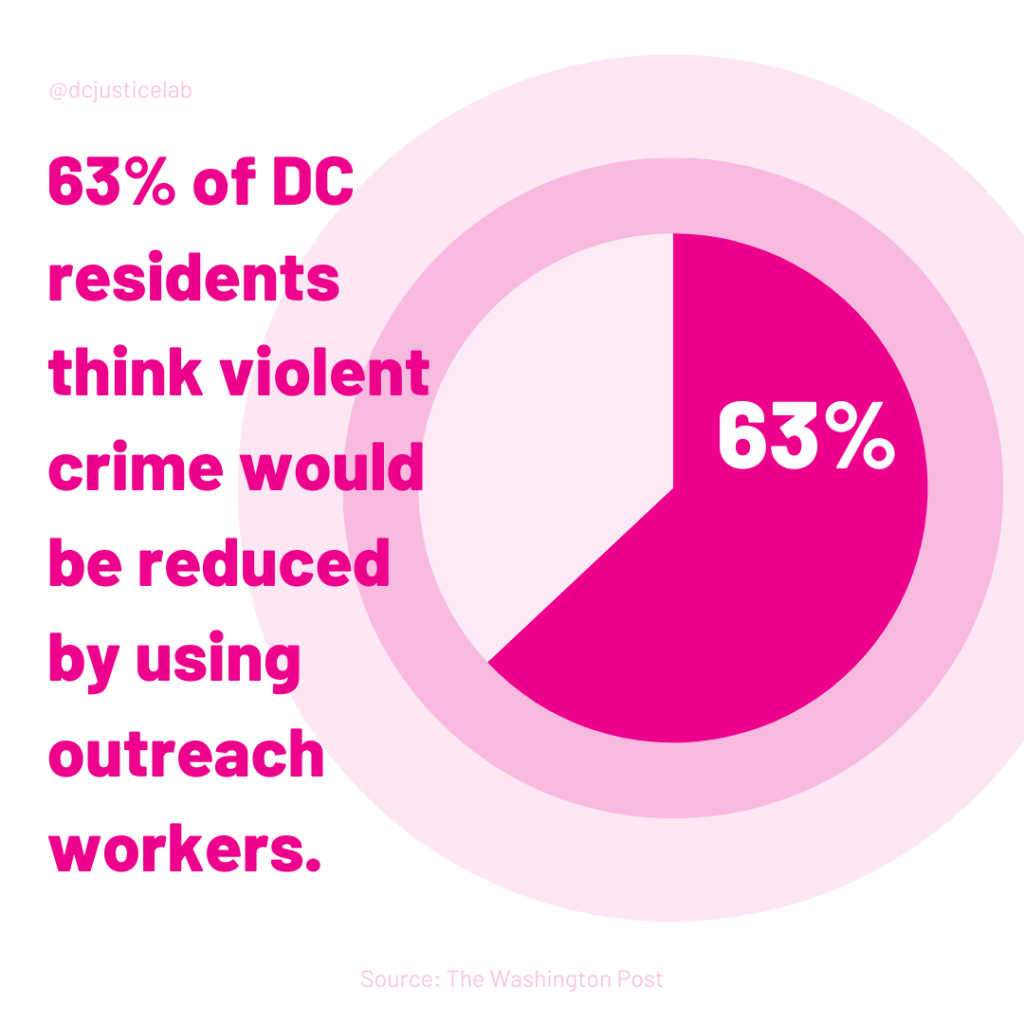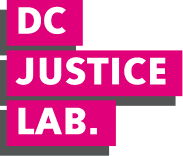
gun violence prevention
DC’s public health plans to reduce gun violence were not fully implemented – and gun homicides increased.
- 5 Minute Read
Gun violence is a public health crisis that costs the District of Columbia $2 billion each year. Black residents are disproportionately impacted by gun violence: 9 out of 10 victims of homicides and nonfatal shootings in DC are Black. While the number of homicides in DC grew in 2023, cities that have advanced public health approaches to gun violence–such as Baltimore, Buffalo, and St. Louis–saw declines in homicides and gun crimes. DC’s version of the public health approach to gun violence prevention was not fully executed, and gun homicides increased in the following years. DC should fully implement its gun violence prevention strategy, pass legislation to better coordinate, strengthen, and expand violence interruption and prevention programs, and review all approaches to curbing gun crimes through a racial equity framework.

What you need to know
Public Health Approach
1. Define and monitor the problem
2. Identify risk and protective factors
3. Develop and test prevention strategies
4. Ensure widespread adoption of effective strategies
A public health approach to gun violence prevention has been shown to increase safety.
Gun violence strategies that use a public health approach can stop the cycle of crime. A public health approach to gun violence prevention sees residents, nonprofit programs, healthcare professionals, and justice institutions build approaches to prevent the behavior from escalating into a violent incident. The Johns Hopkins Bloomberg School for Public Health says the approach should 1) define and monitor the problem, 2) identify risk and protective factors, 3) develop and test prevention strategies, and 4) ensure widespread adoption of effective strategies. The public health approach to gun violence is seeking to address the challenge of reducing the cause of over 80 percent of homicides in DC – where a gun is used to kill someone, and gun crimes create a cycle of crime through retaliation.
Places that implemented gun violence reduction plans saw fewer homicides.
Cities that advanced a public health approach to gun violence prevention have seen big reductions in gun violence. Between 2012 and 2022, Newark saw a 50 percent drop in homicides after expanding programs for people at risk of violence, developing treatment programs for crime survivors, growing prevention programs for young people, and establishing a city office dedicated to keeping the approach going. Unlike the spike in homicides seen in Washington, DC, in 2023, in Newark, homicides have continued to decline. More recently, places like St. Louis, Buffalo, and Baltimore all saw a reduction and homicides in 2023 as they implemented their gun violence reduction plans. Experts who have testified before the Council of the District of Columbia say these communities had consistent coordination, implementation, and follow-up on plans that laid out how these jurisdictions would reduce gun violence.
DC’s public health approach to violence prevention – the NEAR Act – was enacted in 2016.
In the wake of rising gun violence, in 2016, the Council of the District of Columbia unanimously passed the Neighborhood Engagement Achieves Results Amendment Act of 2016 (the NEAR Act). The NEAR Act required the establishment of an Office of Neighborhood Safety and Engagement (ONSE) to help grow violence interruption and the establishment of an Office of Violence Prevention and Health Equity within the Department of Health: the office would have developed a public health strategy to combat the spread of violence using risk assessment tools, cognitive and family-based therapy, and service coordination. The legislation called for the establishment of task forces meant to create comprehensive gun violence prevention plans for the District. The NEAR Act also called for hospitals to establish programs to provide services to gunshot victims and for the development of a program where police and mental health providers work together to respond to and assist people in crisis. The principal author of the NEAR Act said the most critical component of the strategy was consistent coordination of violence prevention efforts.
DC’s NEAR Act was not fully implemented.
The Mayor has said, “each of the 20 provisions of the NEAR Act has been fully funded and implemented by the District.” But the Auditor of the District of Columbia said in two different reports that many provisions were not fully implemented, and two were not implemented at all: DC did not create a police-mental health co-responder program and did not create an Office of Violence Prevention and Health Equity with DC Health. One of the Auditor’s reports said that the violence interruption programs are only targeting a relatively small number of young people for intervention and that “community awareness and involvement in the VI initiative was not consistently strong.” The auditor also reported that task forces on homicide elimination and gun violence prevention strategies were dissolved due to a lack of administrative support. While the hospital-based programs for gunshot victims were established, at a recent hearing, people studying the program said they were not coordinating with outreach workers once individuals returned to the community after being injured, as imagined. Notably, four years after the NEAR Act was passed, the ACLU of DC had to sue the District of Columbia to ensure police stop data was released under law.
DC developed a gun violence reduction strategic plan in 2022.
As the number of homicides in DC reached historically high levels in 2021, the Criminal Justice Coordinating Council commissioned the National Institute for Criminal Justice Reform to develop a gun violence reduction strategic plan for DC. The plan consists of sixteen recommendations focused on violence prevention, intervention, and community transformation. Some of the most critical, non-justice system-related recommendations included providing resources and life coaches for the 200 ‘high-risk’ individuals to where 60 to 70 percent of gun violence episodes can be traced back to, and creating a ‘community resource hub’ to provide services such as healthcare, employment preparation, and counseling. The plan also called for more violence interrupters and a more coordinated training program for them.
DC gun violence prevention strategy was not fully implemented.
In 2023, DC reached its highest level of homicides in twenty years. In December of 2023, the Justice Policy Institute (JPI) cataloged the recommendations from the DC’s gun violence reduction strategy that had not been implemented: the ONSE has shown no signs of increasing the number of violence interrupters. While DC did establish the People of Promise Initiative to focus on the 200 individuals identified as ‘high-risk,’ no information has been released on how many people have been served by this program or on the outcome of the program. Some of the 200 individuals identified to be at the most risk of violence had been killed by gun violence in the intervening time when the National Institute of Criminal Justice Reform updated the plan in 2023. While the gun violence prevention strategy called for a “senior government official to oversee [the] implementation of plan,” no one has been hired or empowered to oversee the plan.
A racial equity framework to prevent gun violence would call for public health approaches - not punitive approaches.
A racial equity framework for gun violence prevention calls for certain key questions to be asked before enacting new policies. These include, “what types of racial disparities could potentially result from the policy’s design and implementation,” and “does the policy remedy existing racial inequities?” The most recent large-scale legislative action by the Council for the District of Columbia to impact gun violence – Secure DC – was assessed by the Council Office on Racial Equity to have a racial equity impact that will “likely exacerbate” and “likely harm” Black residents. By contrast, the racial equity approach calls for focusing on “public health models” and the “social determinants of health” – investments in neighborhoods, economic stability, health care access, and building communities – as the primary strategy to reduce gun violence.

Laws to expand public health approaches to violence are being considered.
As part of a bill that would offer more incentives to hire more police, Safe Neighborhoods Amendment Act of 2024 would also merge all violence interruption work under one organization independent from the Mayor’s office, establish a fund used to provide cash stipends to people at risk of violence and develop a dedicated fund to strengthen the administration of violence prevention programs. The legislation also envisioned increased training, increased wages, and housing assistance to violence intervention workers to address high levels of turnover in the prevention workforce. At the April 2023 hearing on this legislation, the Attorney General for the District of Columbia, organizations representing crime survivors, and reentry providers all expressed support for this plan. The Safe Neighborhoods Amendment Act of 2024 has yet to be enacted.
WHERE TO LEARN MORE
Education Fund to Stop Gun Violence, DC Justice Lab + 5 other public health and violence prevention organizations February 2022
Justice Policy Institute December 2023
National Institute for Criminal Justice Reform December 2023
Alliance for Safety and Justice July 2022
The Washington Post January 2024
National Institute for Criminal Justice Reform May 2022
The Trace April 2024
DC Open Government Coalition March 2024
Professor Joseph Richardson, testimony, Committee on the Judiciary and Public Safety April 2024
Our Solutions
Learning from how other communities reduced gun violence through a public health approach, DC should:
- Fully implement the DC’s Gun Violence Reduction Strategic Plan
- Develop a public website showing progress on implementing the plans
- Have a consistent leadership oversee the gun violence reduction strategy and growth of prevention programs
- Enact the violence prevention components of the Safe Neighborhoods Amendment Act of 2024.
special thanks
Jason Ziedenberg ★ Patrice Sulton ★ Ella Moore


